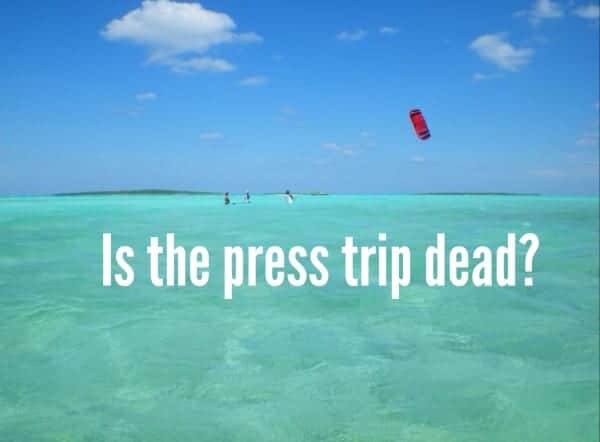Howdy to my communications friends & colleagues! It’s been a while since I’ve addressed any juicy PR / social media / blogging topics here on AngieAway, and since just returned from speaking at TBEX Athens and also hosted today’s PRSA teleseminar on the hot topic of press trips, I figured this is a perfect time to once again peel back the layers on this tender issue.
What exactly is a press trip? You may also hear it called a FAM or a familiarization trip, but no matter what nomenclature is used, essentially it’s a hosted field trip for journalists, bloggers and social influencers to experience a destination (or a product, in some cases) and then convey the experience (honestly & authentically, ideally) to their readers.

First I’ll answer my own question – no, the press trip isn’t dead. It’s just evolved into a nearly unrecognizable entity over the past 10 years. So let’s talk about what’s changed and then dive into some best practices for the modern press trip, shall we?
Leading my first press trip… it was a bit wild.The Old Way in the Old Days
1. Quotas. I started my PR career on the very precipice of the social media age, so while traditional press trips were on the way out, I was still trained in the Old Ways. For my first press trip, I whipped up a boring invitation in Word, probably with ClipArt & WingDings font (I’m sorry!), and sent it to our massive MASTER TRAVEL list of strangers I’d never spoken to from Cision. (I’m sorry!) It didn’t matter so much who was invited as long as I could convince at least 5-6 of them to spend four days with me in my client’s destination. (And that’s how I ended up with so many folks on my personal blacklist.) It was a very cavalier way of doing things, and it did not always go well.
2. Assignment letters. Ten years ago, I required an assignment letter from an editor for any writer joining a trip. Given what clients spend on these trips, it was crucial to do what I could to ensure each attendee’s legitimacy, and to ensure that coverage would likely result from the trip. Assignment letters were a great way to weed out the freebie seekers and the hacks and the so-called “freelancers,” though there were occasional exceptions. Bloggers were unheard of, untested, possibly untrustworthy and certainly not invited during the Old Days.
3. Limited relationship. The life of our FAM-focused PR + salaried journalist-on-assignment relationship went like this: Invite writer. Writer accepts. Travel to destination. Writer sends print clip months later. THE END. There were exceptions for those few brilliant writers who could turn one FAM into years of stories, but those were the most rare of gems.
4. Site inspections and PR dinners. Publicists have clients to please, and in turn, clients have many partners (and possibly taxpayers) to please. Thus my first press trip itineraries were fraught with boring hotel site inspections and uninteresting stops at useless sites no one would ever want to write about. There were lots of arduous dinners with hotel general managers and back-to-back-to-back-to-back packaged activities. No time to relax, no wiggle room for stories to develop naturally – just a crazy busy, jam-packed, partner-pleasing itinerary.
5. Generic focus. In most cases, press trips back in the day were not a part of a large, focused campaign. Instead they often resulted from late afternoon boss brainstorms… “We haven’t done a press trip in a while. Go plan one!” The itineraries were similarly planned to include partners and hotels who pay into the tourism board, not necessarily following any grand scheme, interesting event or specialized niche.
6. Itinerary hell. Yuck. Remember the binders and print-outs and edits and constant updates to each individually copied-and-pasted itinerary? CRINGE. We spent so much time printing out press kits and coordinating this drudgery. All billable, of course, but drudgery nonetheless, and mostly useless once the adventure began and flights were delayed and the schedule changed upon arrival anyway.
The night before a press trip, circa 2007As a publicist once tasked with planning these OG snoozefests (I’m so sorry!), I’m happy to say after a trip or two I saw the light and began to change my game plan, focusing on finding that magical combination that would satisfy everyone’s needs.
- A win for the writer.
- A win for the client.
- A win for the publicist.
That’s a lot of winning from three very demanding groups! But it can be done. And now, it’s a different game. So what’s changed and what’s on the horizon? Read on….

Welcome to the Modern Press Trip
1. Targeted invitations. When a destination or hotel client asks me to coordinate a media visit now, I know exactly who to invite based on personal relationships and knowledge of each invitee’s niche. There is no reason in 2014 to send out blind invitations to a master media list. Publicists today (should) have a much better idea of which writers are out there living in the travel space and who would be a fit for our clients. We should never, ever send a travel invitation that is not clearly directed to a specific writer for a specific purpose. (And if you aren’t sure who to invite, ask other publicists who’s great and who’s on the BLACKLIST, check out successful social campaigns on Twitter/Instagram, meet people at TBEX and subscribe to Blogger Bridge.) In this day and age, formal invitations are practically unnecessary. Once you’ve developed relationships with key bloggers, you can just DM them on Twitter with details. It’s so much easier than the Old Way.
2. We’ve gone digital. Forget about staples and binders and copy-and-pasting and printing itineraries until 3 a.m. the night before a trip. Now I use TripIt to coordinate travel for groups – big and small. I just send all travel info including train tickets, hotel and flight reservations, EventBrite confirmations, driving directions, etc. to [email protected] and they’re all added into one easy-to-read itinerary. Boom – I just saved 12+ hours! All travelers can participate in the itinerary online from a tablet, laptop, iPhone – wherever. It saves countless hours in the planning stage, and automatically alerts you when flights are delayed en route. (And for the staunchest fans of the Old Days, you can still print out a hard copy with all the information included – no need to copy and paste into Word.)
3. Breathable, functional, realistic itineraries. Instead of herding our journalists from hotel to excursion to site inspection to lunch to excursion… you get the idea… with no room to breathe or think or sleep or work, now we factor in time to find individual stories outside of our packaged group itineraries. Good publicists ask for feedback on the itinerary in advance in order to meet a writer’s needs, focusing on providing information & activities to create a beautiful, useful finished product rather than rushing around trying to satisfy every destination partner. This is ideal, though not always possible. Some publicists are more equipped than others to please all parties. It’s a challenge. If you work with a publicist who does this well, hold on to him or her.
4. Clear expectations for delivery. We used to invite writers to our destinations, but due to the ethical gray area inherent in the press trip model, we could never officially require coverage. So press trips, which can cost a blue-a$$ fortune, could amount to absolutely nothing, the writer didn’t have to explain his/her reasons for not writing, and there was little to be done about it. Ten years later, the whole landscape has changed. Now, it’s absolutely acceptable to talk about expectations up front – and I prefer it. Everyone knows what they need to do, so there are no surprises and no one can claim ignorance. (Yes, there’s space to discuss options if the experience doesn’t go as planned. Obviously.)
5. There’s more to the story. The writers of today do so much more than write. They’re content creators, bloggers, videographers, Instagram celebrities and Facebook experts. The wordsmiths of today’s travelsphere have much more to offer than a hotel review or a magazine blurb about your client – so don’t be afraid to talk about how you can work together to get even more content from one trip.
6. Payment. This is a conversation for another post on another day, but payment was NEVER discussed for press trips in times past. Now, it’s a different story. Many of the influencers you’d like to invite on a trip are not on salary as were the assignment-letter carrying journos of the Old Days, and yet blogging/content creation is their occupation and they do need to get paid for their efforts and time in some way. The job description is different, the expectations can be very different, thus I believe it’s fully within the realm of ethical behavior to pay a blogger for their time, photographs, etc. (Paying for editorial magazine coverage is still technically frowned upon, but ad buys are a common way of circumventing that issue.) No matter what, both sides – the blog side and the PR side – are responsible for their own personal integrity. (And there’s another side – the reader – who must also decide if they trust the blogger’s opinion. Like I said, another story for another day!)
Ten years after my first trip and the FAM is all grown up. Much of the credit goes to the increased flexibility and versatility that bloggers have brought to the travel world, so… three cheers for the blogosphere!
Have you planned or attended a press trip in either the Old Days or recently? What changes have you noticed in the way things are done?
Up next… a birthday post!
